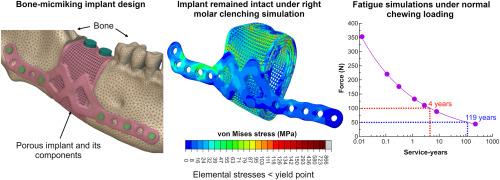Prototype design of porous Ti6Al4V intraosseous implant for use in mandibular reconstruction
IF 3.5
2区 医学
Q2 ENGINEERING, BIOMEDICAL
Journal of the Mechanical Behavior of Biomedical Materials
Pub Date : 2025-07-25
DOI:10.1016/j.jmbbm.2025.107144
引用次数: 0
Abstract
The design of patient-specific implants often requires computer simulations for the characterization of mechanical properties before manufacturing. We previously developed numerical models to predict the mechanical properties of porous Ti6Al4V constructs built using laser powder bed fusion (LPBF). Here, we developed a patient-specific porous intraosseous mandibular implant based on the models and techniques described in our previous research. The implant model used a simple cubic porous design with an average unit cell size of 1 mm and strut thicknesses between 350 and 450 μm. Finite element analysis was used to simulate right molar clenching on the mandible with and without the implant, under static and dynamic loading. The simulation showed that the implant would remain intact during right molar clenching and should not cause stress shielding. The fatigue numerical models predicted that the implant would remain functional under cyclic masticatory forces (50–100 N) for a period ranging between 4 and 119 years. Given that, within one year, bone ingrowth and osseointegration are complete, the implant is predicted to remain intact long-term under physiological loading conditions. These findings demonstrate the potential of computational modelling in developing patient-specific designs for porous implants built through LPBF.

多孔Ti6Al4V骨内种植体用于下颌骨重建的原型设计
患者特异性植入物的设计通常需要在制造前进行计算机模拟以表征机械性能。我们之前开发了数值模型来预测使用激光粉末床熔合(LPBF)构建的多孔Ti6Al4V结构的力学性能。在此,我们基于先前研究中描述的模型和技术开发了一种针对患者的多孔骨内下颌种植体。植入物模型采用简单的立方多孔设计,平均胞元尺寸为1 mm,支撑厚度在350 ~ 450 μm之间。采用有限元分析方法,模拟有种植体和不含种植体的下颌右磨牙在静态和动态载荷下的咬合。模拟结果表明,在右磨牙咬合过程中,种植体保持完整,不会产生应力屏蔽。疲劳数值模型预测,在循环咀嚼力(50-100 N)的作用下,种植体将在4至119年的时间内保持功能。鉴于在一年内,骨长入和骨整合完成,预计种植体在生理负荷条件下长期保持完整。这些发现证明了计算模型在开发通过LPBF构建的多孔植入物的患者特异性设计方面的潜力。
本文章由计算机程序翻译,如有差异,请以英文原文为准。
求助全文
约1分钟内获得全文
求助全文
来源期刊

Journal of the Mechanical Behavior of Biomedical Materials
工程技术-材料科学:生物材料
CiteScore
7.20
自引率
7.70%
发文量
505
审稿时长
46 days
期刊介绍:
The Journal of the Mechanical Behavior of Biomedical Materials is concerned with the mechanical deformation, damage and failure under applied forces, of biological material (at the tissue, cellular and molecular levels) and of biomaterials, i.e. those materials which are designed to mimic or replace biological materials.
The primary focus of the journal is the synthesis of materials science, biology, and medical and dental science. Reports of fundamental scientific investigations are welcome, as are articles concerned with the practical application of materials in medical devices. Both experimental and theoretical work is of interest; theoretical papers will normally include comparison of predictions with experimental data, though we recognize that this may not always be appropriate. The journal also publishes technical notes concerned with emerging experimental or theoretical techniques, letters to the editor and, by invitation, review articles and papers describing existing techniques for the benefit of an interdisciplinary readership.
 求助内容:
求助内容: 应助结果提醒方式:
应助结果提醒方式:


